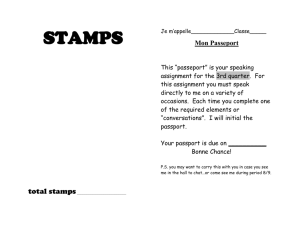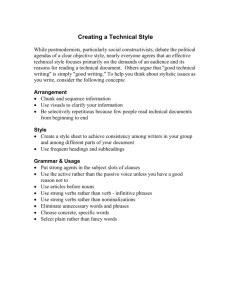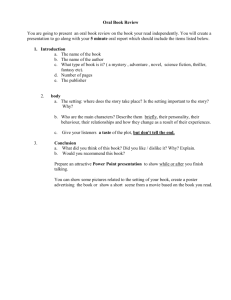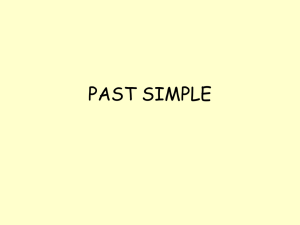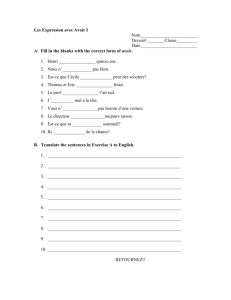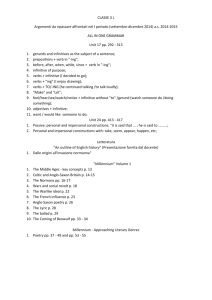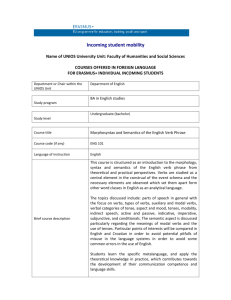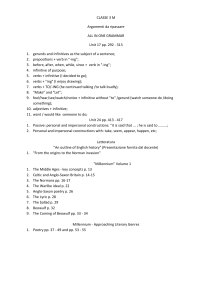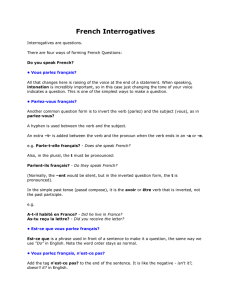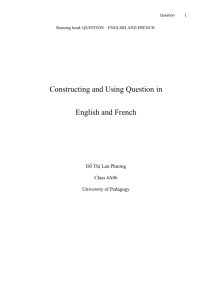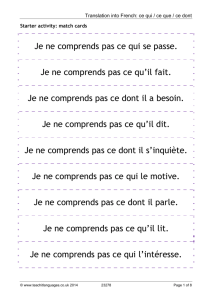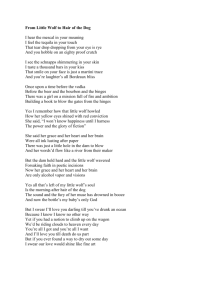Meta-linguistic outcomes - Leeds Trinity University
advertisement
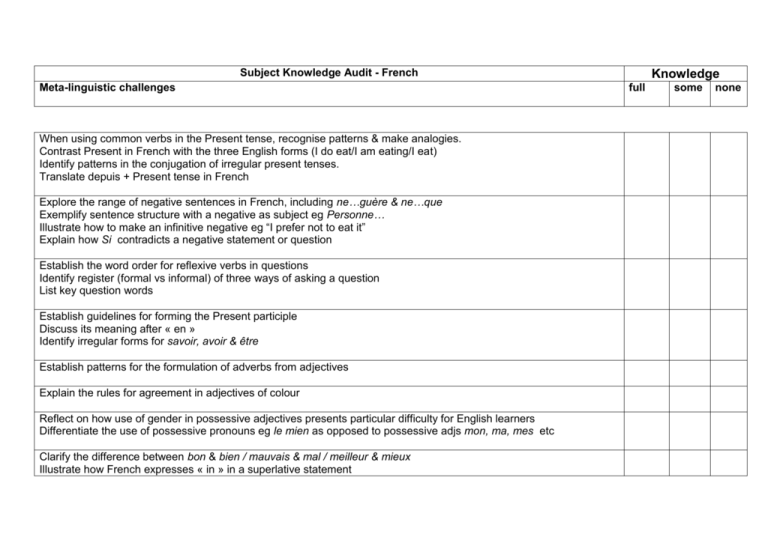
Subject Knowledge Audit - French Meta-linguistic challenges When using common verbs in the Present tense, recognise patterns & make analogies. Contrast Present in French with the three English forms (I do eat/I am eating/I eat) Identify patterns in the conjugation of irregular present tenses. Translate depuis + Present tense in French Explore the range of negative sentences in French, including ne…guère & ne…que Exemplify sentence structure with a negative as subject eg Personne… Illustrate how to make an infinitive negative eg “I prefer not to eat it” Explain how Si contradicts a negative statement or question Establish the word order for reflexive verbs in questions Identify register (formal vs informal) of three ways of asking a question List key question words Establish guidelines for forming the Present participle Discuss its meaning after « en » Identify irregular forms for savoir, avoir & être Establish patterns for the formulation of adverbs from adjectives Explain the rules for agreement in adjectives of colour Reflect on how use of gender in possessive adjectives presents particular difficulty for English learners Differentiate the use of possessive pronouns eg le mien as opposed to possessive adjs mon, ma, mes etc Clarify the difference between bon & bien / mauvais & mal / meilleur & mieux Illustrate how French expresses « in » in a superlative statement Knowledge full some none Contrast the use of the definite article in French and its use in English Contrast the use of the indefinite article in French and its use in English Explore the use of de as opposed to the partive des and establish guidelines Compile a list of prepositions whose use is unlike English, e.g. 9 sur 10, donner sur …. Explore different meanings of chez Establish the patterns of prepositions with countries & cities Identify patterns and draw analogies between regular & irregular past participles Discuss which verbs are more likely to take avoir in the past; explore the concept of transitive / intransitive verbs Name a few verbs which can take either être or avoir in the past and explain why . Explore the use of the past infinitive after après Discuss the formulation of guidelines to explain the difference in usage between the passé composé & imperfect tenses Explain the preceding direct object rule. Establish patterns for the position of direct object pronouns in negative & interrogative sentences. Discuss why English pupils find the indirect object pronouns lui & leur challenging Explain the differences between: Elles se sont vues & Elles se sont écrit. Explain the use of y & en Give examples of French use of a singular verb after a group noun How is distance away from expressed in French? Exemplify descriptions of dimension eg 2 metres wide Explain how to express approximate numbers Comment on the use of commas & full stops in numbers in French and English Explain the difference between 2 mille, 2 milliers , 2 millions & 2 milliards Express fractions in French Write 200 & 216 as words and explain the spelling pattern Exemplify the use of double future tenses in sentences in French with time clauses, including use of the future perfect Relate the use of pour / pendant + time ( eg 2 mois) to different tenses How is en 2 mois different? Formulate guidelines for the formation of the Conditional. Consider the journalistic use of the Conditional & Conditional Perfect to express lack of certainty eg Il y aurait 2 blessés How many different ways can could be translated? Consider the meaning of devoir in the conditional. Contrast the meaning of Je devrais with that of J’ai dû & Je devais Explain how qui & que function as relative pronouns Establish the function of Qu’est-ce qui? / Qui est-ce qui? / Qu’est-ce que? / Qui est-ce que? Explain the difference between ceux qui & ce qui. Explain the different usages of C’est vs Il est Consider how French expresses English passive constructions How does French avoid the full Passive voice? Exemplify the pattern of tenses used with Si and compare with tenses in English after “If” Consider use of structure être en train de to express aspect How can “-ing” be translated into French with the infinitive? Establish three groups of structures: Verb + à + infinitive / verb + de + infin. / verb + infin. Exemplify more complex structures Establish a list of alternatives to a full subjunctive clause when there is no change of subject of the verb eg avant de / à condition de/ afin de + infinitive. Classify connectives into categories of time, consequence, reason & purpose. Explore key differences between the Indicative & Subjunctive moods and exemplify their usage. Explore the concept of the « grey » subjunctive eg Crois-tu qu’il a tort ? vs Crois-tu qu’il ait tort ? Consider when Inversion occurs other than in questions Explore the sociolinguistic implications of using tu or vous forms of address in different contexts such as the home, the workplace, school and the army Reflect on ways to explain the function of accents in French Ensure you know the characters for typing accents in Word Discuss the most common faux amis eg sensé = sensible sensible = ? Discuss the difference between usage of savoir & connaître Establish the difference in meaning between penser à & penser de and jouer à & jouer de Distinguish the use of visiter vs rendre visite à Collect idioms based on avoir Research proverbs that begin with the structure en + -ant Research idioms + body parts eg J’ai mal au coeur Establish key expressions for classroom management and also the language of feedback eg Bon travail
